|
Nine Dragon Heads at
the SarajevoWinter2006
|
|
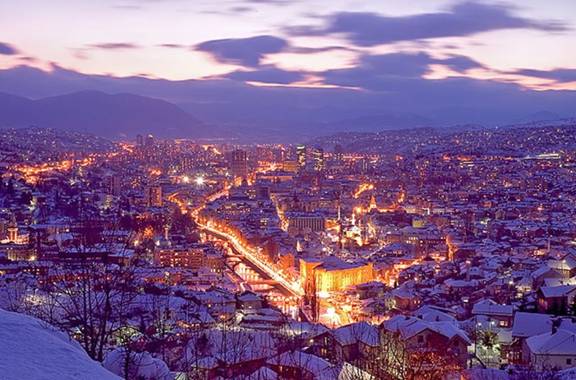
|
The Sarajevo Winter Festival (Sarajevska Zima) has been running
continuously since 1984, when it was founded as an adjunct event to the
Sarajevo Winter Olympics. It has
continued every year, including during the war, which began on April 6th
1992, when Serb militants opened fire on thousands of peace demonstrators in Sarajevo, killing at
least five and wounding 30. The siege
continued until October 1995, the longest city siege in history. We heard stories of people ducking sniper
fire on their way to festival venues.
There are bullet holes in Festival Director Ibrahim Spahic’s office
walls; shrapnel in his head, we were told. With this history of incredible
defiance and commitment, Sarajevo’s annual arts,
jazz and film festivals are now some of the major cultural events in Eastern Europe.
|
Artists from throughout
the world travel there to participate, and to enjoy the warm hospitality of the
people of Sarajevo. At the same time,
visitors new to this pretty city observe evidences of ravages of war. They no longer experience what Susan Sontag
described when she directed Waiting for
Godot at the fetsival: ‘Bombs went off, bullets flew past my head.... There
was no food, no electricity, no running water, no mail, no telephone, day after
day, week after week, month after month.’
Sontag explains that the
continuance of arts activities during the war as a ‘serious expression of
normality’. Evidence and stories of
those hardships, and worse, still abound. In the very first hour of one’s
visit, one sees that this is a city of new cemeteries. Pristine white marble
tombstones are present everywhere one looks, in areas that were once the city’s
parks.
|
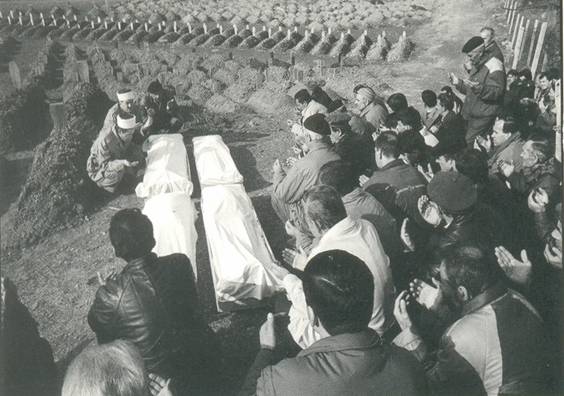
|
Postcard 1abelled ‘1992 Sarajevo 2002’. Purchased in Sarajevo.
|
This is indeed sobering for the visitor from a
distant place; visitors who knew about the genocide, because they saw it on
television. That mass exposure did not mean the world could stop it. In our distant countries we saw scenes of
Europeans starving behind barbed wire, disturbingly like 1945 all over again.
The dreadful term ‘ethnic cleansing’ entered everyday language.
|
For artists attending the
winter arts festival in February 2006, the highly apparent physical residues of
war on the cityscape – the cemeteries, bullet holes in the facades of
buildings, demolition sites, even postcards of war scenes - were a raw and immediate form of
consciousness-raising
|
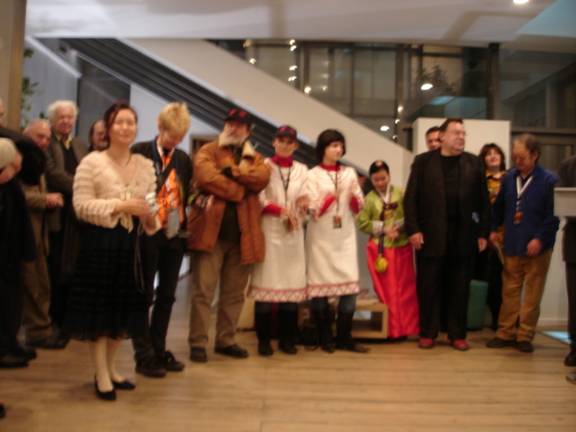
|
Internationalism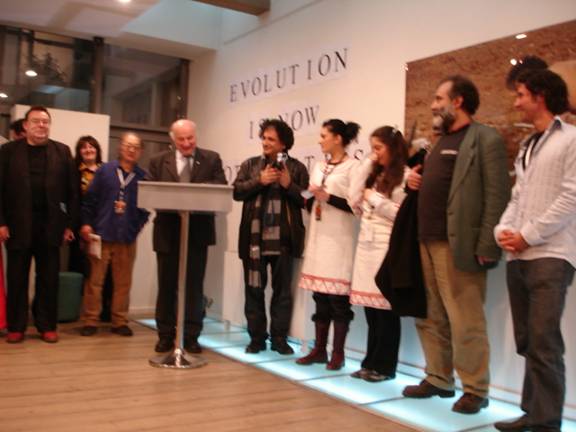
The 2006 official Sarajevska Zima catalogue was in excess
of 200 pages, indicating the vast scale and range of this event: musical
theatre, puppeteers, photographers, musicians, singers, dancers, video
installations, tableau vivant, city illuminations, events for children. Nine Dragon Heads was just one group of the many who
participated in the festival in 2006.
|
Nine Dragon Heads is a changing group of artists, co-ordinated by Park Byoung Uk
(Korea) The emphasis in this group is on the
internationalism of their work; for most of this group, it would be difficult
to identity their country of origin by their work.
|
|
|
The 2006 Nine Dragon Heads group included artists from places
as diverse as Bosnia-Herzogovnia, Turkey, Japan,
Korea, Australia, New
Zealand, Switzerland
and Norfolk Island. All of these artists have
traveled and worked in various countries; their work is documented in a wide
range of international texts. Most have websites featuring their work. There
has never been a time in history
when artists could be as international.
|
Artists in the city – creating spectacles
Nine Dragon Heads held their exhibition at the Turkish Cultural Centre on Mula
Mustafe Baseskije for one week, February 8th - 14th
2006. For some of the artists, their
work in this show was their sole outing at this festival.
|
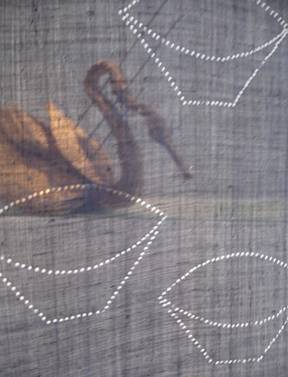 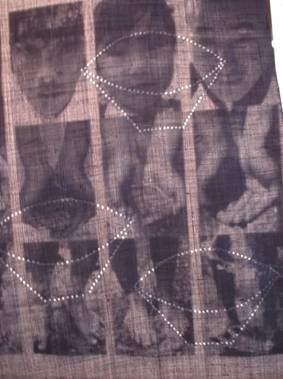
|
Joung-Hye Yoo (Korea) created a wall installation of small
colorful raffia flower-like pieces in bright orange and yellow: a radiant
blossoming of nature/ culture from elsewhere, flourishing in the bleak Sarajevo winter.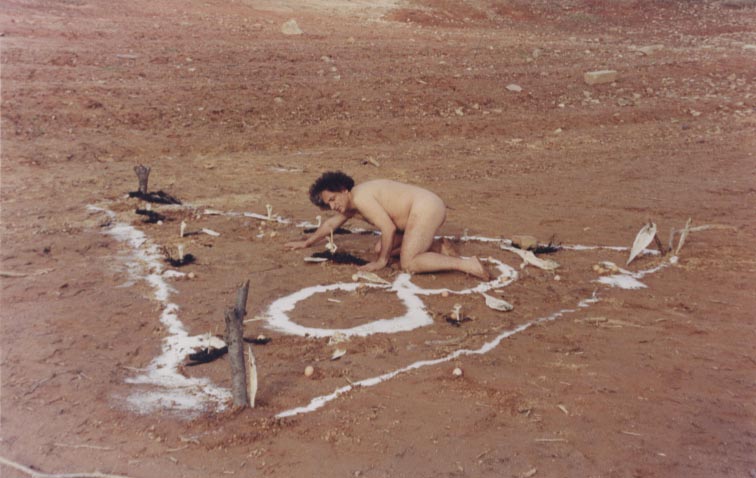
|
|
|
Bedri Baykem’s (Turkey)
photographs of himself as Natural Man crawling naked amongst beach debris on a
lake edge in Korea
also recalled another place and climate, far away. His work could be read as
comment on the anti-conservation ‘achievements’ of human evolution.
|
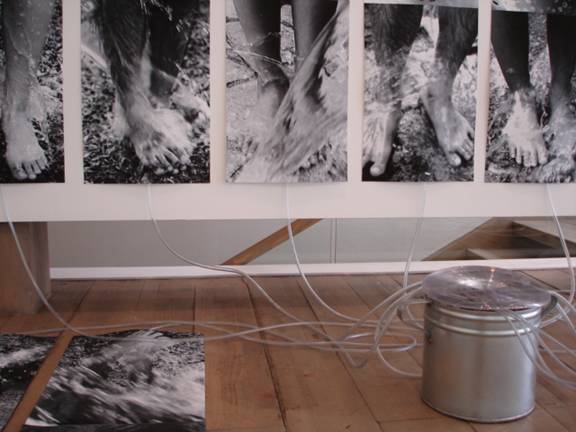
|
Ichi Ikeda (Japan)
reiterated this theme in his political and environmental concerns for water
preservation. His work is famous for its elegant depiction of water as a
fragile consumable: a natural resource that has become a commodity. Here he exhibited a wall montage of large black
and white photographs of water running through the hands of people trying,
impossibly, to hold it; and an
installation of soil, tubing and fresh water, referring to the depletion of
this precious life source. His work invites not just reflection, but
also urgent political action to ensure its future availability.
|
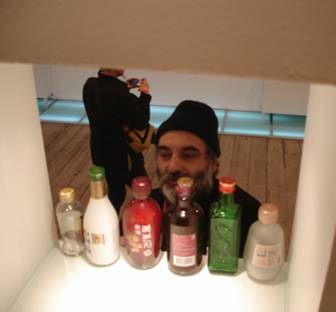 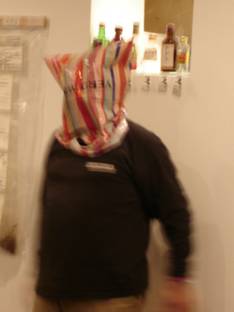
|
In a different vein,
Jusuf Hadzifejzovic (Bosnia
-Herzogovnia) presented a performance about escape from darkness: the confined
body blinded by its enclosure – a colorful plastic bag – and forced to poke its
way out into the light. The drama of
this piece’s reference to imprisonment was poignant expression of the
conditions the citizens of this country endured during the war: under siege in
their own homes, wondering when and how there could possibly be a way out.
|
At the same time the materiality of this work – a simple plastic
bag - pointed to the everyday nature of the scope for such enclosing of people:
high-end technology is not necessary for
extreme cruelty. (We recall the use of simple
box-cutters as lethal weapons in the September 11th attacks). Hadsifejzovic’s escape was also a bursting
from the bag of his own forceful artistic personality: a dynamic metaphor for
the positive character of the city of Sarajevo
itself, which utilized the arts as an expression of refusal to be confined
during the war.
|
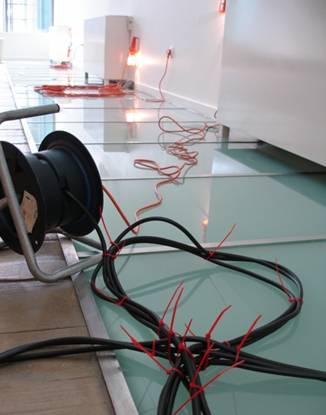 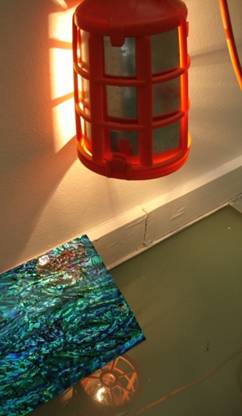
|
Some of the artists
stayed in Sarajevo
for at least another week, to participate in the festival and to make work in
the city and its environs. This was the
making of work outside the gallery; or entire city as gallery. The Nine Dragons Heads artists were not frivolous
tourists. They took very seriously this opportunity to engage with the city; to
be part of the normality of a city which did, after all, host this festival for
several years before the war.
|
Most of the group had not
planned their specific outdoor works before the festival; they had waited to
explore the city to locate suitable sites. There was also a day at the Sarajevo
Winter Olympic ski-field, to make art during a major snowboarding competition.
|
|
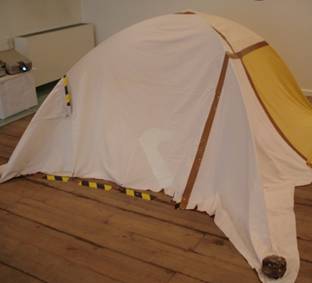 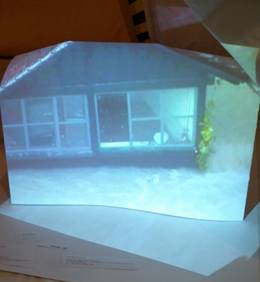
|
Swiss installation artist
and videographer Susanne Muller explained that she liked to search for voids,
and make the otherwise un-noticed spaces in a city into a visual event. ‘We can
never know every part of a city, even our own city’. She brought with her to Sarajevo lightweight tent
frames, and then searched locally for materials to make the tents’ canopies. A
second-hand shop near the Turkish Cultural Centre yielded plenty of used cotton
sheets. She installed one tent in the Nine Dragon Heads exhibition at the Turkish Cultural
Centre, where inside the tent flaps a television monitor ran a continuous loop
of 24 –frames-per-second.
|
The content featured
recent floods in Switzerland,
particularly near her home city of Bern:
a local catastrophe beamed out to the world.
This poignant inversion of shelter, the cataclysm inside the totally
unfunctional tent, sat in the context of the reparation of the houses and
public buildings of Sarajevo.
|
A few days later another
of her tents appeared in the burnt-out shell of the Hotel Europa. Through the former window spaces of this
demolition site, her brave little tent sat in the snow, an apparent shelter for
survivors of the 1990s siege. A few days
later Mustafa Skolpjak (Bosnia
and Herzogovnia) placed large cutout figures in the empty window frames.
|
The derelict hotel was
now inhabited once again.
Muller’s work was a timely echo of another tent site in the city.
|
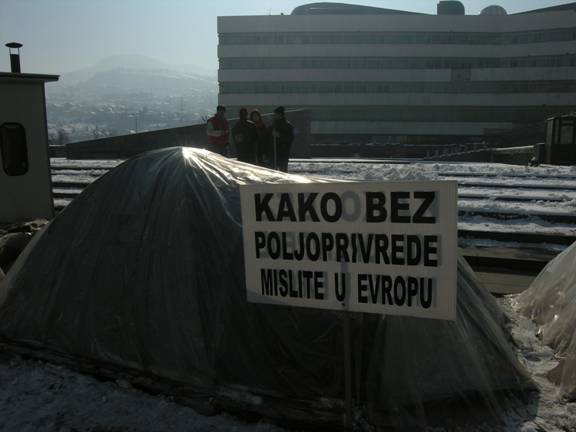
|
Part of the protest camp
of agricultural workers near the National
Museum.
|
On Marsala Tito near
the National Museum agricultural workers had been
camping for 235 days, in protest against the lack of government support for
agriculture. Their tents were on low
platforms in the snow. Despite lack of language in common, by showing them her
Visiting Artist tag and footage of her work on her video camera, she was able
to convey to them her solidarity with their cause. They laughed and indicated their own small
‘Olympic flame,’ and a great pile of firewood.
They handed out sweets. Muller
was invited to do an installation that included their tents, in situ.
|
|
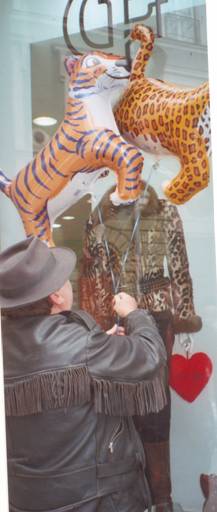 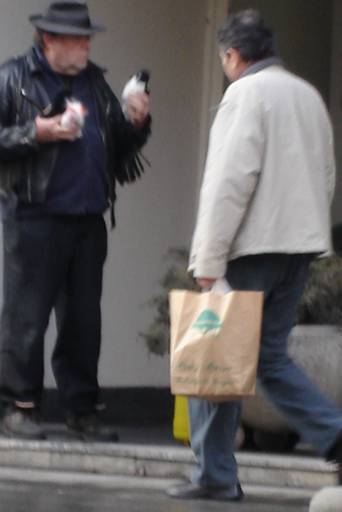
|
|
John Lyall and de-nature
myth.
|
Meanwhile at Basčarsija John Lyall (New Zealand)
threw seed to the pigeons, hoping they would arrange themselves in the
formations of the marks he was trying to make with the grain. The pigeons would
not co-operate, but quickly ate the grain.
People seated outside the cafes watched as the pigeons engulfed him. His
marks without the pigeons were more successful: Cartesian swirls foot-printed
into the snow at Basčarsija and at Vogosca, which
remained visible for several days, and aroused local curiosity. The elegance of
these shapes echoed his work in the Nine Dragon Heads
gallery exhibition: the same mathematical curves assembled from orange and
black extension leads, with inspection lamps shining onto sheets of New Zealand
native paua shell (iris haliotis). In his gallery performance piece the
same curves appeared as cut-outs of postcards, the perforations heavily
outlined in lipstick, as in ‘sent with love from…’
|
He also became a fixture wandering
around the town with two helium inflated animals bought from street
sellers: a feral tiger and leopard. They stared at sumptuous fur coats in shop
windows; they bobbed against the formal framed photographs of Marshal Tito,
décor at Tito Café. They were finally
released into the Miljacka
River, where they swirled
about in the weirs, only to be eventually washed up on the frosty shore: a foreign environment indeed for these two
stray lost creatures.
|
|
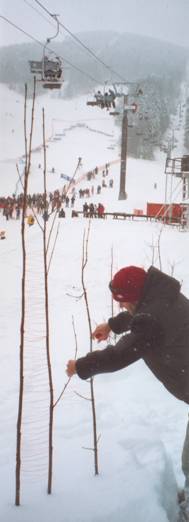 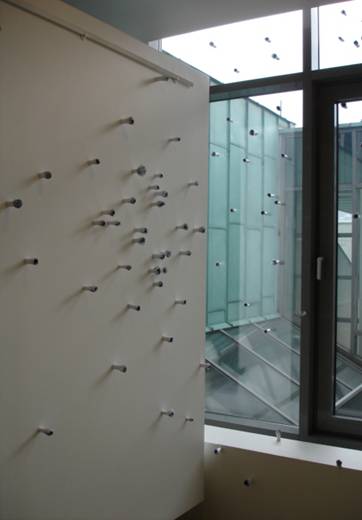
|
Miles Sanderson from Norfolk
Island installed fruit –
large luscious oranges – as regularly spaced architectural motifs along
the bridge famous as the location of the assassination of Archduke Franz
Ferdinand. As in his gallery
work, a drift of rolled paper sea anemones, his emphasis was on order,
symmetry, and surprise achieved by using simple, readily available materials.
The fruit glowed in the dim wintry afternoon mist. Gypsy children hung about, waiting for the
artist to finish, and maybe give them the oranges.
|
Sanderson reflected on this later. ‘I won’t use food again
in an installation in a place where people cannot afford fruit’. In a later work, at the ski-field of the 1984
Sarajevo Winter Olympics, he used red string to make marks in the snow, and to
tie around winter twigs that poked up through the ice crystals. The quiet elegance the red streaks on the
shimmering white ground was respectfully resonant of blood in the snow, a
tribute to the lives lost throughout this region during the war. We’d all seen the ‘roses of Sarajevo’, indentations from the
explosion of mortar shells on the city’s pavements, filled with red concrete in
remembrance of those killed.
|
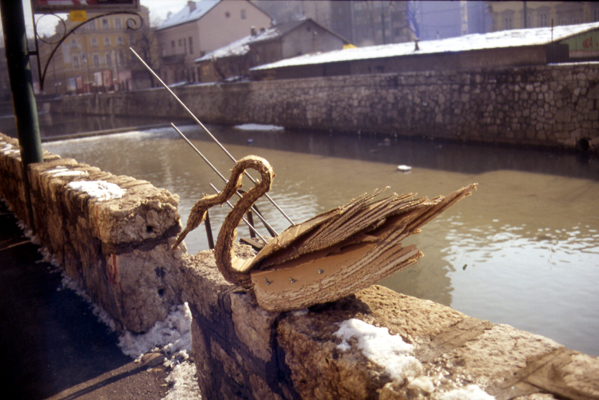
|
Video still: Ali Bramwell
walks her sawn through the streets of Sarajevo.
|
Meanwhile at the ski-field Ali Bramwell
(New Zealand)
laboured hard to turn snow into a large swan. Her life-sized swan, layers of
corrugated cardboard stabbed with metal shafts, reposed on a gently-lit ledge
in the Turkish Cultural Centre gallery.
It referenced silent tales of migration, while inferring all those
mythic, figurative and mystical cultural references to swans; and the current
global alarm and doom-saying about Avian flu, predominant in news broadcasts
that week. Would this disease be the
next apocalypse? Would it strike this
city, too, still recovering from another disaster?
|
Ali Bramwell took her swan for a walk around the streets of Sarajevo.
|
In Svetlost Park
the work took its final form, ‘Walking with swan: stone sleeper.’ Bramwell describes this walk:
|
‘It began at the bust of Mak
Dizdar (Bosnian poet) and ended at the National Museum.
The Swan (labud) was bolted together from cardboard cartons collected in the
city, in itself a different kind of document, a kind of stored history in both
material (used boxes stamped and labelled) and form (the image of swan is
overlaid with many layers of poetic and mythic history). I placed the swan
beside Dizdar. For the walking performance I tied the swan to my body with 9
metres of black satin ribbon, wrapped around and around my chest and walked
dragging it trailing behind me. It took just over half an hour to walk the
distance.’
|
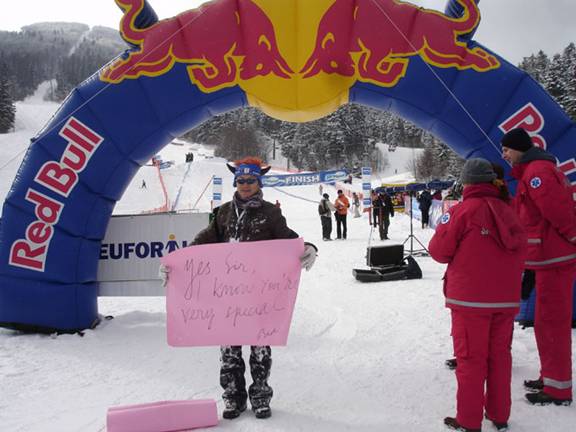
|
Consummate performer
Park Byoung-Uk’s
irrepressibility was a constant motif during the weeks the Nine Dragon Heads
group worked in Sarajevo. At the ski-field, once snowboarding
competition had finished, Park raced beneath the banner labeled ‘Finishing
Line’ and threw himself in the snow. In his arms he clutched the handmade sign
he carried on behalf of fellow Nine Dragon Heads
artist, Bedri Baykam, ‘Yes sir, I know
you’re very special’. As one of the
founders of Nine Dragon Heads, he
has delivered artists over and again to venues throughout the world. For him,
performing as an artist is also about facilitating the performance of others.
|
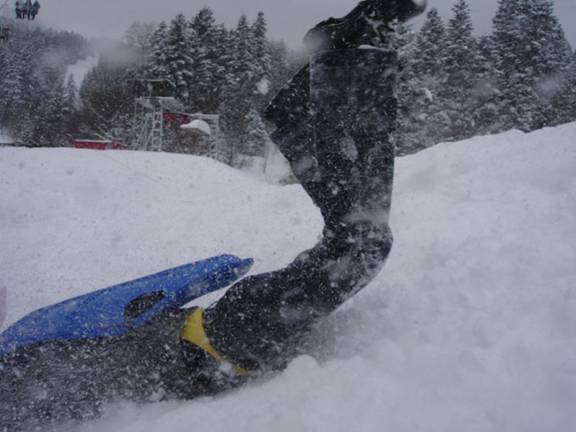
|
Park’s medium is the everyday actions
of people in nature, going about their lives. His fluorescent orange jumpsuit
foregrounds the artist, the brand Park Byoung-Uk. But once he has donned this garment, his actions in the social context are so
everyday and perfectly positioned within the actually quotidian of others, that
he simply appears to be a municipal official, or an official organizer – a
trenchant wit that translates remarkably across cultures.
|
Performing
in Sarajevo – the joy of participation
|
Whatever distance they had traveled and
however different their own cultures from the everyday life they experienced or
observed in Sarajevo, these artists could not be oblivious to the context in
which they found themselves. Here was a city where the citizens had survived
unimaginable nightmares in recent memory.
It is still addressing issues of survival. At the same time,
here was city with sufficient support from citizens and government to stage
several ambitious annual festivals.
|
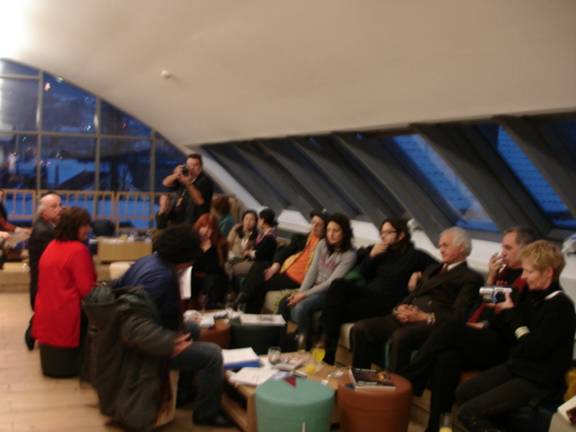
|
The artists installing objects and
performing events in the city contributed to the festive feel of Sarajevo in wintry
February. They invited a genuine
democracy of viewer participation and enjoyment, unfettered by any need for
formal aesthetic sanction on visual pleasure.
|
Sarajevo’s icy streets became galleries of inclusion, not exclusion.
The artists’ works in the square, on the bridge, in the river, at a derelict
hotel, in any void Suzanne Muller could find, were public presentations for
anyone who cared to look. Indeed, this
invitation to artists to make work anywhere in the city may be seen as a graphic counter to the
alienation of art in many city galleries all over the world, where the
immaculate intimidating hushed white
spaces are irrelevant to perpetual non-visitors. The street and ski-field works
bore no inherent sense of the sacred or precious, no suggestion that one must
have some elusive insider prior knowledge to read these presentations. The artists were creating blatant spectacles
for every single person passing by.
|






















